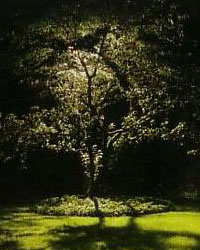The next category of landscape lighting we’re going to discuss is Down Lighting. As we mentioned before, each category of landscape lighting contains its own different techniques. Using a combination of the techniques will help you achieve a gorgeous and secure outdoor environment.
Down Landscape Lighting
 Down lighting is simply the term used when you want to illuminate something from above. Suppose you have a garden and want to illuminate certain elements or areas; down lighting could do that and could also help illuminate larger spaces.
Down lighting is simply the term used when you want to illuminate something from above. Suppose you have a garden and want to illuminate certain elements or areas; down lighting could do that and could also help illuminate larger spaces.
Down lighting can also provide a shadow effect similar to that of a moon lit night. To create an even more uniform effect you could have light patterns overlapping to soften the shadows.
Five Main Lighting Techniques
1. Washing or Grazing – This technique diffuses light over a wide vertical area. You could use this technique to enhance natural or architectural surfaces. To achieve this effect the fixtures are typically placed within 6-8” of the surface with the beam of light aimed parallel to the surface. Grazing techniques can be achieved with spot, well, and flood lights. It all depends on the width of the area you want to illuminate.
2. Spot Lighting – If you want to illuminate individual architectural elements or a garden, spot lighting is the way to go. Spot lighting uses narrow, focused beams of light. Hooded spot fixtures make the object or area stand out from the background which in turn draws the attention of the onlooker. Well lights and mounted fixtures that can be moved up and down work great for illuminating vertical elements such as the home’s columns or even the tree trunks.
3. Silhouette – Should you want a silhouette effect you could place lights behind elements or other objects to provide an outline of the source and create a dramatic effect.
4. Shadow – A shadow technique is similar to a silhouette but the light is placed in front of an element, for instance plant material, with a tall adjacent wall. This creates the dramatic shadows as the back drop. If your landscaping is relatively new and you have shorter shrubs and plants this would be a great lighting choice. It can transform the smallest plant or a plain, large wall into something bigger and better.
5. Moonlight – Many people enjoy the effect of the moonlighting technique. It provides the most natural light form by having the light source higher above the garden, like in the trees. The light is then diffused downward through the branches and leaves, creating shadow patterns on the ground. The moonlight technique is perfect for those wanting a more subtle, ambient type of illumination. It’s popular for driveways, patios and lawns. Spot fixtures can be used for creating the moonlight effect but certain hanging fixtures can sometimes provide the same, if not more interesting effect.
Our next post (part 3) will go into illuminating paths and walkways with Path or Step lighting.
Proactive Landscaping – Your Broken Arrow Landscape Lighting Professionals
For a free consultation your landscape lighting project, contact Proactive Landscaping today.

